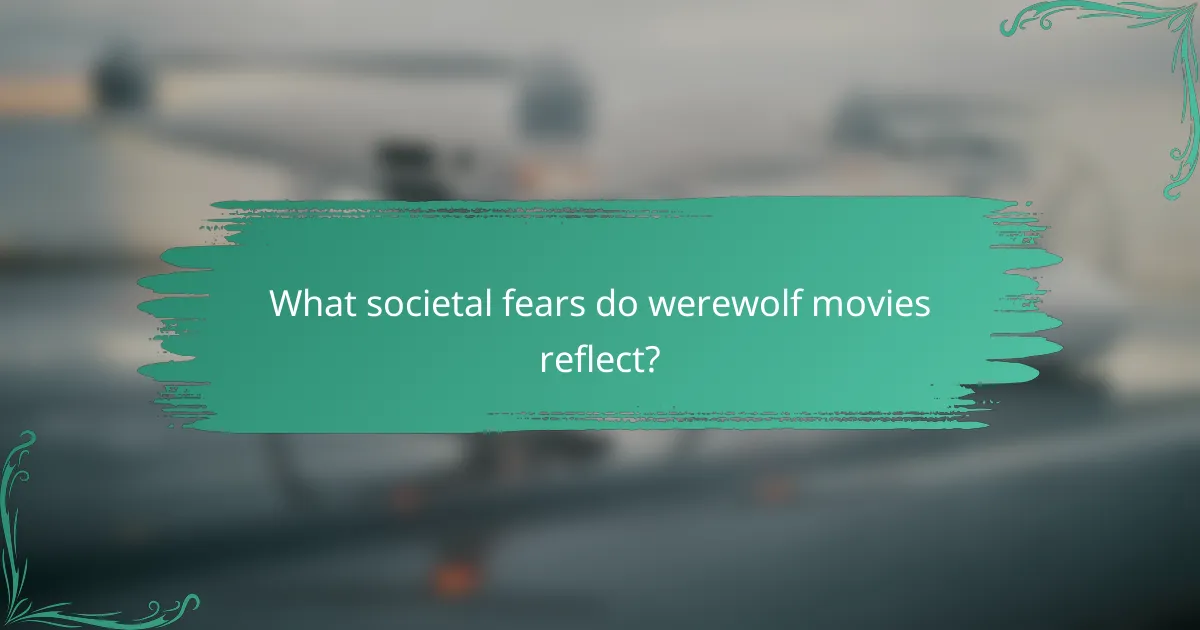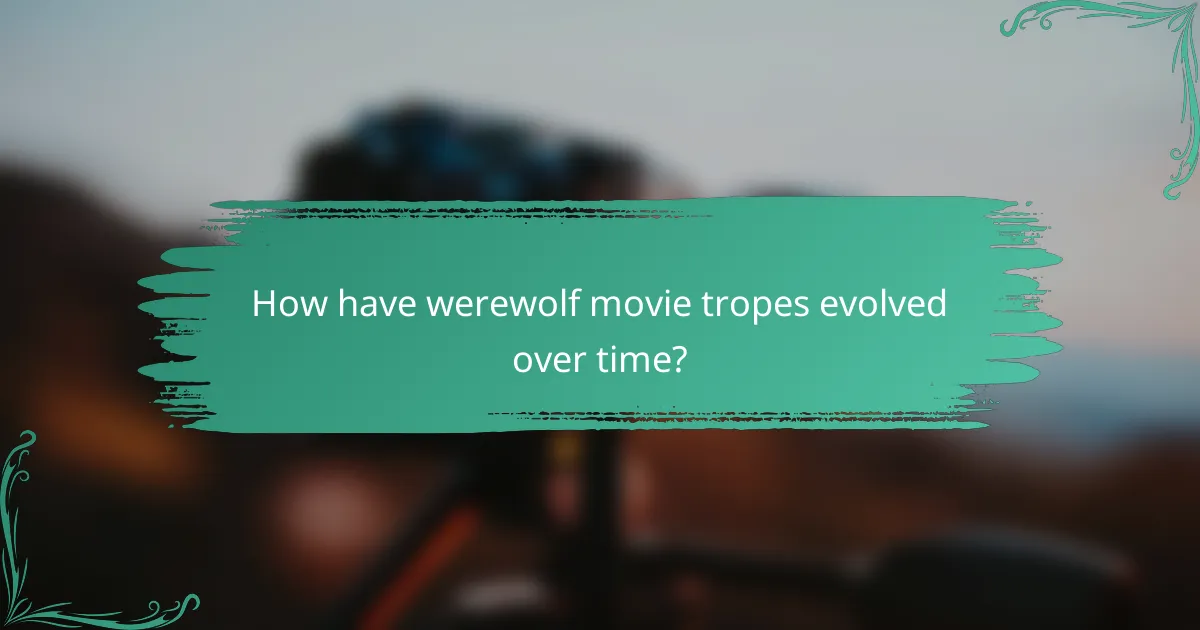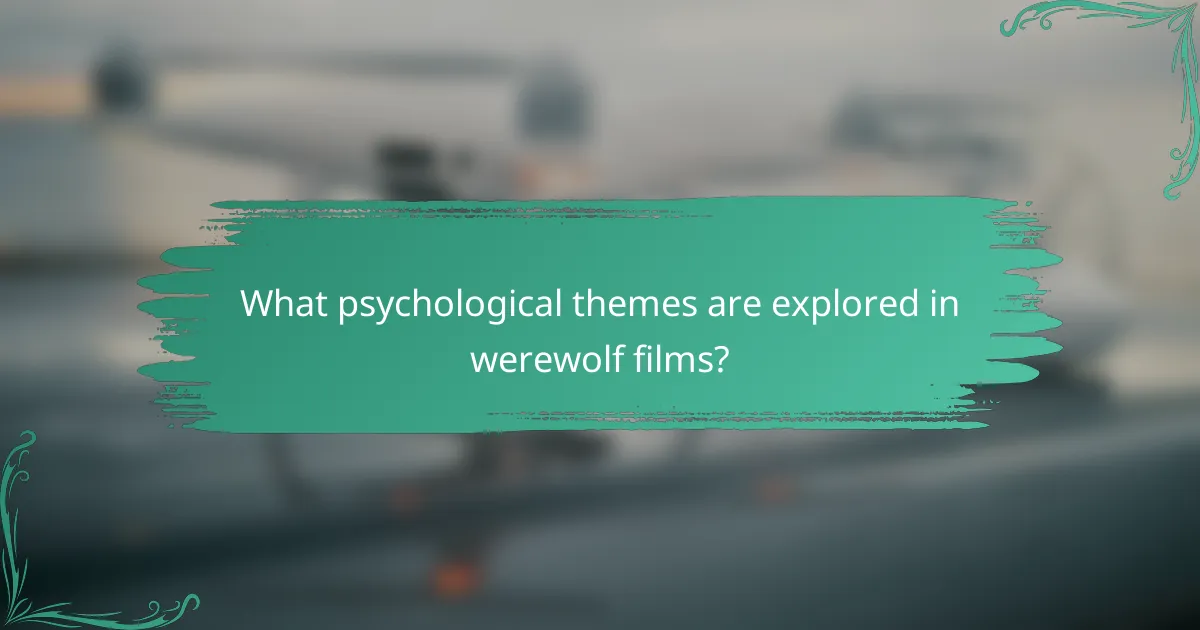Werewolf movies serve as a compelling lens through which to examine societal fears, particularly those related to loss of control and transformation. By depicting the struggle between humanity and monstrosity, these films resonate with audiences, reflecting anxieties about personal identity and societal norms. As the genre evolves, it continues to mirror the changing cultural contexts and fears of its time.

What societal fears do werewolf movies reflect?
Werewolf movies often mirror deep-seated societal fears, particularly those surrounding loss of control, the unknown, transformation, societal rejection, and violence. These themes resonate with audiences, reflecting anxieties about personal identity and societal norms.
Fear of loss of control
The fear of loss of control is a central theme in werewolf films, where characters often transform into uncontrollable beasts. This transformation symbolizes the struggle against inner demons and the unpredictability of human nature.
For example, a character may start as a mild-mannered individual but, under the full moon, becomes a violent creature. This duality reflects societal concerns about losing grip on one’s actions and morality, especially in stressful situations.
Fear of the unknown
Werewolf movies tap into the fear of the unknown by presenting the transformation process as mysterious and often terrifying. The unpredictability of when and how someone might change into a werewolf creates tension and suspense.
This fear resonates with audiences, as it highlights the anxiety surrounding unfamiliar experiences and the potential consequences of those experiences. The unknown can lead to paranoia and mistrust, both in the films and in real life.
Fear of transformation
The fear of transformation in werewolf narratives often reflects broader anxieties about change and identity. Characters face a physical and psychological metamorphosis that challenges their sense of self and societal roles.
This theme resonates particularly in cultures experiencing rapid change, where individuals may feel pressure to adapt or risk losing their identity. The werewolf serves as a metaphor for the fear of becoming something unrecognizable.
Fear of societal rejection
Societal rejection is a prevalent theme in werewolf films, where transformed characters often face ostracism from their communities. This reflects fears of being marginalized or alienated due to differences.
In many stories, the werewolf is depicted as a tragic figure, struggling to reconcile their dual nature while fearing rejection from loved ones. This mirrors real-world issues of acceptance and belonging, particularly for those who feel different or misunderstood.
Fear of violence
The fear of violence is a prominent aspect of werewolf movies, showcasing the potential for brutality that lies within. The transformation into a werewolf often leads to violent outbursts, symbolizing the darker aspects of human nature.
This theme can serve as a commentary on societal violence and the thin veneer of civilization that can be shattered under stress. Audiences are confronted with the reality that everyone has a capacity for violence, which can emerge unexpectedly.

How have werewolf movie tropes evolved over time?
Werewolf movie tropes have evolved significantly, reflecting changing societal fears and cultural contexts. From early portrayals emphasizing monstrous transformation to modern interpretations that explore psychological and moral dilemmas, these films mirror the anxieties of their times.
Classic vs. modern interpretations
Classic werewolf films often depicted the creature as a straightforward monster, embodying primal fears of the unknown and loss of control. In contrast, modern interpretations frequently focus on the internal struggle of the werewolf, highlighting themes of identity, morality, and the consequences of human actions. This shift allows for deeper character development and a more nuanced exploration of fear.
For example, films like “The Wolf Man” emphasize the tragic nature of the werewolf, while contemporary works such as “Dog Soldiers” and “Ginger Snaps” incorporate elements of social commentary, addressing issues like gender roles and the impact of war.
Impact of cultural shifts
Cultural shifts have profoundly influenced werewolf movie tropes, aligning them with societal concerns. In the early 20th century, fears of disease and the unknown were prevalent, leading to portrayals of werewolves as uncontrollable beasts. As societal views on mental health and identity evolved, so too did the narratives surrounding werewolves, often reflecting contemporary issues such as alienation and the struggle for acceptance.
For instance, the rise of [censured] representation in media has led to werewolf stories that explore themes of transformation and self-acceptance, resonating with audiences seeking relatable narratives.
Technological advancements in filmmaking
Technological advancements have significantly shaped the portrayal of werewolves in film. Early practical effects were limited, often relying on makeup and costumes to convey transformation. Today, CGI and advanced prosthetics allow for more realistic and dynamic depictions of werewolf transformations, enhancing the visual impact of these films.
Moreover, improved sound design and cinematography contribute to the overall atmosphere, making the horror elements more immersive. Films like “An American Werewolf in London” set a high standard for transformation scenes, blending practical effects with innovative techniques that continue to influence the genre.
![]()
What are the most iconic werewolf movies?
Some of the most iconic werewolf movies include “American Werewolf in London,” “Ginger Snaps,” “Dog Soldiers,” and “Wolfman.” Each film uniquely explores the werewolf mythos while reflecting societal fears and cultural themes.
American Werewolf in London
The film is notable for its groundbreaking special effects, particularly the transformation scene, which set a new standard in the genre. It also reflects fears of the unknown and the consequences of straying from familiar environments.
Ginger Snaps
“Ginger Snaps” offers a unique take on the werewolf narrative by intertwining themes of adolescence and female empowerment. The story follows two sisters as one of them undergoes a transformation that symbolizes the challenges of growing up and the societal pressures faced by young women.
This film stands out for its exploration of identity and the fear of change, using the werewolf metaphor to address issues such as puberty and the loss of innocence. It resonates particularly with audiences who appreciate horror that critiques societal norms.
Dog Soldiers
“Dog Soldiers” is a British horror film that combines military action with werewolf lore. A group of soldiers on a training mission in the Scottish Highlands encounters a pack of werewolves, leading to a fight for survival that tests their camaraderie and resolve.
This film effectively uses the backdrop of military culture to explore themes of loyalty and fear. The tension between man and beast reflects societal anxieties about warfare and the primal instincts that emerge in life-or-death situations.
Wolfman
The 2010 remake of “Wolfman” pays homage to the classic 1941 film while updating its themes for modern audiences. It tells the story of Lawrence Talbot, who returns to his ancestral home and is cursed to become a werewolf, grappling with his identity and the legacy of his family.
This version emphasizes the tragic elements of the werewolf myth, focusing on the internal struggle between humanity and monstrosity. It highlights fears of hereditary curses and the impact of one’s lineage on personal identity.

How do werewolf movies compare to other horror genres?
Werewolf movies often explore themes of transformation and loss of control, setting them apart from other horror genres. Unlike vampire or zombie films, werewolf narratives typically focus on the internal struggle of the protagonist, emphasizing the conflict between humanity and primal instincts.
Comparison with vampire movies
Vampire movies frequently highlight themes of seduction and immortality, contrasting sharply with the werewolf’s struggle with their own nature. While vampires often represent allure and danger, werewolves embody the fear of losing one’s humanity. This difference creates distinct emotional experiences for viewers, with werewolf films leaning more towards tragedy and internal conflict.
Additionally, vampires are often portrayed as sophisticated and cunning, whereas werewolves are depicted as raw and chaotic. This distinction influences the storytelling techniques and character development in each genre, making werewolf films more focused on personal transformation.
Comparison with zombie movies
Zombie movies typically emphasize societal collapse and the loss of civilization, while werewolf films delve into personal identity and the duality of human nature. In zombie narratives, the threat is external and often overwhelming, whereas werewolf stories center on the internal battle of the individual against their monstrous side.
Moreover, zombies are often depicted as mindless, creating a sense of dread through sheer numbers, while werewolves retain their intelligence and emotional depth. This allows for more nuanced character arcs and moral dilemmas in werewolf films, making them resonate on a more personal level.
Unique narrative structures
Werewolf movies often utilize a unique narrative structure that emphasizes transformation and the consequences of that change. Many stories begin with the protagonist’s normal life, followed by the gradual revelation of their werewolf nature, leading to a climax that tests their humanity.
This structure allows filmmakers to explore themes of identity, fear, and acceptance, often culminating in a tragic or redemptive conclusion. Unlike the straightforward horror of zombie or vampire films, werewolf narratives invite viewers to reflect on the complexities of human nature and the struggles within.

What psychological themes are explored in werewolf films?
Werewolf films delve into various psychological themes, primarily focusing on the duality of human nature, the struggle for control, and the fear of the unknown. These themes reflect societal anxieties about identity, transformation, and the primal instincts that lurk beneath the surface of civilized behavior.
Duality of human nature
The duality of human nature is a central theme in werewolf films, showcasing the conflict between the civilized self and the primal beast within. This struggle often symbolizes the internal battles individuals face when confronted with their darker impulses. Characters may grapple with their humanity while being overtaken by their animalistic instincts, representing the fear of losing control.
For example, in films like “An American Werewolf in London,” the transformation into a werewolf serves as a metaphor for the loss of moral restraint and the emergence of violent tendencies. This duality resonates with audiences, reflecting their own fears of succumbing to base desires in a society that demands conformity.
Transformation and identity
Transformation in werewolf films often represents a deeper exploration of identity and self-perception. The physical change into a wolf not only signifies a loss of control but also raises questions about who the character truly is. This theme resonates with societal fears of change and the unknown, particularly in contexts such as adolescence or personal crises.
Films like “The Wolfman” illustrate how the protagonist’s transformation leads to a crisis of identity, forcing them to confront the parts of themselves they wish to suppress. This struggle can mirror real-life experiences where individuals feel torn between societal expectations and their true selves.
Fear of the unknown
The fear of the unknown is a pervasive theme in werewolf films, as characters often face the terror of what they cannot understand or predict. This fear manifests in the unpredictability of the werewolf’s actions and the chaos it brings to the familiar world. Audiences relate to this theme as it reflects broader societal anxieties about change and the uncontrollable aspects of life.
In movies like “Ginger Snaps,” the werewolf serves as a catalyst for exploring themes of fear and uncertainty during the transition from adolescence to adulthood. The unknown elements of transformation and the consequences that follow highlight the inherent dangers of embracing change without understanding its implications.
